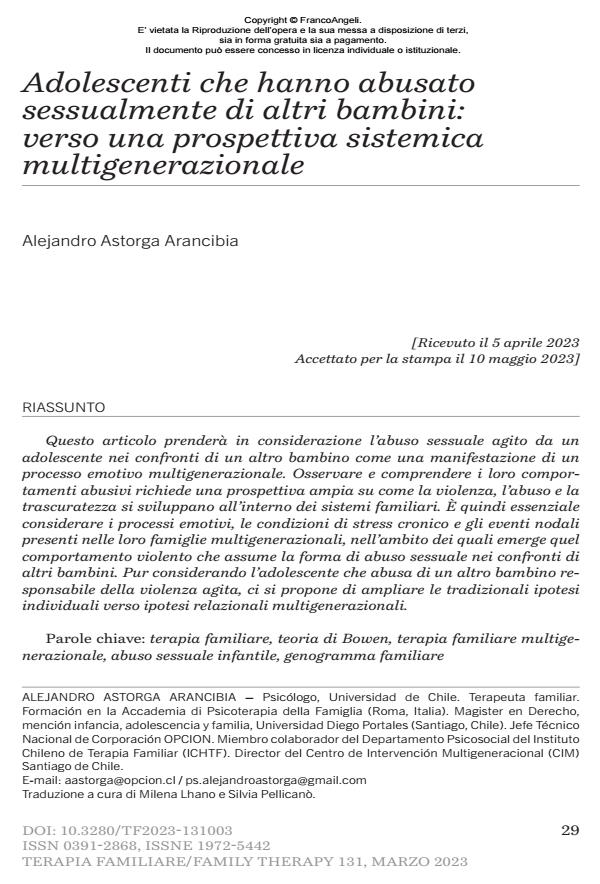Adolescents who have sexually abused other children: towards a multigenerational systemic perspective
Journal title TERAPIA FAMILIARE
Author/s Alejandro Astorga Arancibia
Publishing Year 2023 Issue 2023/131
Language Italian Pages 16 P. 29-44 File size 642 KB
DOI 10.3280/TF2023-131003
DOI is like a bar code for intellectual property: to have more infomation
click here
Below, you can see the article first page
If you want to buy this article in PDF format, you can do it, following the instructions to buy download credits

FrancoAngeli is member of Publishers International Linking Association, Inc (PILA), a not-for-profit association which run the CrossRef service enabling links to and from online scholarly content.
This article will discuss how the sexual abuse that an adolescent develops towards another child can be understood as a manifestation of a multigenera- tional emotional process. Observing and understanding their abusive behaviors requires a broad perspective on how violence, maltreatment and abuse develop in family systems. Therefore, it’s essential to consider the emotional processes, chronic stress conditions and nodal events present in their multigenerational family, under which abusive behavior emerges, taking the form of sexual abuse toward other children. While considering that the adolescent who abuses another child is responsible for the act he/she has developed, it is proposed to extend the traditio- nal individual hypotheses to multigenerational relational hypotheses.
Keywords: family therapy, Bowen Theory, multigenerational family therapy, child abuse, family diagram
- Astorga A. (2018). Guía para la construcción y análisis del diagrama familiar cen- trado en la situación de niño, niña o adolescente desde una mirada de derechos y con miras a su presentación en reunión técnica. In: OPCION (ed). Intervención en infancia desde un enfoque de Derechos Humanos (pp. 78-113). Documento de trabajo n. 8. Santiago de Chile: Gráfica LOM.
- Astorga A. (2021). Young teenagers who abuse of other children: a perspective from Bowen family systems theory. Presentación en el 59th Annual Symposium on family theory and family psychoterapy, 6 noviembre. Bowen Center for the study of the family, Washington DC.
- Bowen M. (1989). Terapia Familiar en la práctica clínica. Bilbao: Descleé de Brouwer.
- Breinbauer C. & Maddaleno M. (2008). Jóvenes: opciones y cambios. Promoción de conductas saludables en los adolescentes. Washington DC: OPS-OMS.
- Cantón J. & Cortés M.A. (1997). Malos tratos y abuso sexual infantil: Causas, con- secuencias e intervención. Madrid: Siglo XXI.
- Colapinto J. (1995). Dilution of Family Process in Social Services: Implications for Treatment of Neglected Families. Family Process, 34(1): 59-74.
- Cutajar M., Mullen P., Ogloff J., Thomas S., Wells D. & Spataro J. (2010). Psychopathology in a large cohort of sexually abused children. Child abuse & neglect, 34(11): 813-22.
- Echeburúa E. & Guerricaechevarría C. (2000). Abuso sexual en la infancia: víctimas y agresores. Barcelona: Ariel.
- Echeburúa E. & Corral P. (2006). Secuelas emocionales en víctimas de abuso sexual en la infancia. Cuadernos de Medicina Forense, 12: 43-44. DOI: 10.4321/S1135-76062006000100006
- Finkelhor D. & Browne A. (1985). The traumatic impact of child sexual abuse: A conceptualization. American Journal of Orthopsychiatry, 55(4): 530-541.
- Kerr M. & Bowen M. (1988). Family Evaluation: An approach based on Bowen Theory. New York: W.W. Norton & Company.
- Kerr M. (2019). Bowen theory’s secrets revealing the hidden life of families. New York: Norton Professional Books.
- McGoldrick M. & Gerson R. (2000). Genogramas en la evaluación familiar.
- Barcelona: Gedisa, 3ª edición.
- OPCION (2005). Programa Socioeducativo para el control de la violencia y de la agresión sexual. Santiago de Chile: Editorial Corporación Opción.
- OPCION (2013). CAS-R Programa para el tratamiento para el control de la agresión sexual. Documento de Trabajo n. 4. Santiago de Chile: Editorial gráfica LOM. OPCION (2019). T-CACS Tratamiento para niños, niñas y adolescentes que presen-tan conductas abusivas de carácter sexual. Documento de Trabajo n. 10. Santiago de Chile: Editorial gráfica LOM.
- Pereda N. (2010). Consecuencias psicológicas a largo plazo del abuso sexual infantil. Papeles del Psicólogo, 31(2): 191-201.
- Pinheiro P. (2010). Informe Mundial sobre la violencia contra los niños y las niñas. Madrid: UNICEF.
- SENAME (2019). Orientación técnica programa especializado en intervención con adolescentes que presentan conductas abusivas de carácter sexual (PAS). Santiago de Chile: Departamento de protección de derechos, Servicio Nacional de Menores.
- Smith W. (2021). Child abuse and Child Welfare System. Presentación en el 41 Annual Pittsburgh Family Systems Conference and Symposium, 22 octubre. The Western Pennsylvania Family Center, Pittsburgh.
- Smith W. (2001). Child abuse in Family Emotional Process. Family Systems: A journal of Natural Systems Thinking in Psychiatry and the Sciences, 5(2): 101-126.
- Titelman P. (ed.) (1998). Clinical applications of Bowen Family Systems Theory. New York: The Haworth Press.
- Titelman P. (ed.) (2007). Triangles: Bowen Family Systems Theory Perspectives. New York: The Haworth Press.
- Titelman P. (ed.) (2015). Differentiation of Self: Bowen Family Systems Theory Perspectives. New York: Routledge.
- UNICEF (2012). Cuarto estudio de maltrato infantil. Santiago de Chile: UNICEF. UNICEF (2021). Covid-19 and School Closures: One year of education disruption. -- Disponibile al sito: data.unicef.org/wp-content/uploads/2021/03/COVID19- and-school-closures-report.pdf (ultima consultazione: 17/11/2022).
- Valenzuela E., Murillo J., Santelices M., Hamilton J. & Muñoz C. (2022). Resultados Primera Encuesta Nacional de Abuso Sexual y Adversidades de la Niñez. Presentación CUIDA.
Alejandro Astorga Arancibia, Adolescenti che hanno abusato sessualmente di altri bambini: verso una prospettiva sistemica multigenerazionale in "TERAPIA FAMILIARE" 131/2023, pp 29-44, DOI: 10.3280/TF2023-131003